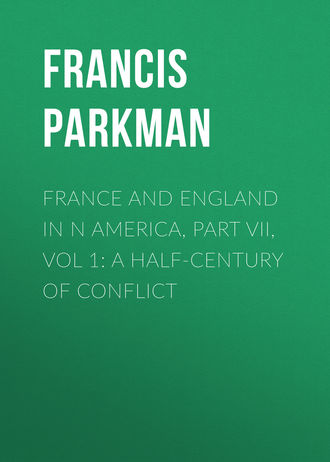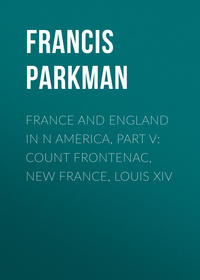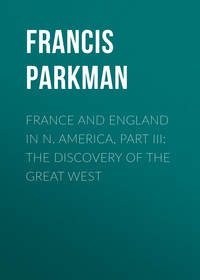 полная версия
полная версияFrance and England in N America, Part VII, Vol 1: A Half-Century of Conflict
37
La Mothe-Cadillac à Ponchartrain, 31 Août, 1703. "Toute impiété à part, il vaudroit mieux pescher contre Dieu que contre eux, parce que d'un costé on en reçoit son pardon, et de l'autre, l'offense, mesme prétendue, n'est jamais remise dans ce monde, et ne le seroit peut-estre jamais dans l'autre, si leur crédit y estoit aussi grand qu'il est dans ce pays."
38
Ponchartrain à La Mothe-Cadillac, 14 Juin, 1704.
39
Deed from the Five Nations to the King of their Beaver Hunting Ground, in N. Y. Col. Docs., iv. 908. It is signed by the totems of sachems of all the Nations.
40
Count Frontenac, 231.
41
Ibid., chaps, xi. xvi. xvii.
42
Penhallow, History of the Wars of New England with the Eastern Indians, 16 (ed. 1859). Penhallow was present at the council. In Judge Sewall's clumsy abstract of the proceedings (Diary of Sewall, ii. 85) the Indians are represented as professing neutrality. The governor and intendant of Canada write that the Abenakis had begun a treaty of neutrality with the English, but that as "les Jésuites observoient les sauvages, le traité ne fut pas conclu." They add that Rale, Jesuit missionary at Norridgewock, informs them that his Indians were ready to lift the hatchet against the English. Vaudreuil et Beauharnois au Ministre, 1703.
43
Penhallow, 17, 18 (ed. 1859). There was a previous meeting of conciliation between the English and the Abenakis in 1702. The Jesuit Bigot says that the Indians assured him that they had scornfully repelled the overtures of the English, and told them that they would always stand fast by the French. (Relation des Abenakis, 1702.) This is not likely. The Indians probably lied both to the Jesuit and to the English, telling to each what they knew would be most acceptable.
44
See "Count Frontenac," 371.
45
Bourne, History of Wells and Kennebunk.
46
The above particulars are drawn from the History of Wells and Kennebunk, by the late Edward E. Bourne, of Wells,—a work of admirable thoroughness, fidelity, and candor.
47
On these attacks on the frontier of Maine, Penhallow, who well knew the country and the people, is the best authority. Niles, in his Indian and French Wars, copies him without acknowledgment, but not without blunders. As regards the attack on Wells, what particulars we have are mainly due to the research of the indefatigable Bourne. Compare Belknap, i. 330; Folsom, History of Saco and Biddeford, 198; Coll. Maine Hist. Soc., iii. 140, 348; Williamson, History of Maine, ii. 42. Beaubassin is called "Bobasser" in most of the English accounts.
48
The careful and well-informed Belknap puts it at only 130. History of New Hampshire, i. 331.
49
Charlevoix, ii. 289, 290 (quarto edition).
50
Penhallow, Wars of New England with the Eastern Indians.
51
Doddridge, Notes on Western Virginia and Pennsylvania.
52
On this affair, see the note of Elisha Plaisted in Massachusetts Archives; Richard Waldron to Governor Dudley, Portsmouth, 19 September, 1712; Bourne, Wells and Kennebunk, 278.
53
Vaudreuil au Ministre, 14 Novembre, 1703; Ibid., 3 Avril, 1704; Vaudreuil et Beauharnois au Ministre 17 Novembre, 1704. French writers say that the English surprised and killed some of the Abenakis, who thereupon asked help from Canada. This perhaps refers to the expeditions of Colonel March and Captain Tyng, who, after the bloody attacks upon the settlements of Maine, made reprisal upon Abenaki camps.
54
English accounts make the whole number 342.
55
Stephen W. Williams, Biographical Memoir of Rev. John Williams.
56
Account of ye destruction at Derefd, February 29, 1703/4.
57
Papers in the Archives of Massachusetts. Among these, a letter of Rev. John Williams to the governor, 21 October, 1703, states that the palisade is rotten, and must be rebuilt.
58
The names of nearly all the inhabitants are preserved, and even the ages of most of them have been ascertained, through the indefatigable research of Mr. George Sheldon, of Deerfield, among contemporary records. The house of Thomas French, the town clerk, was not destroyed, and his papers were saved.
59
On the thirty-first of May, 1704, Jonathan Wells and Ebenezer Wright petitioned the General Court for compensation for the losses of those who drove the enemy out of Deerfield and chased them into the meadow. The petition, which was granted, gives an account of the affair, followed by a list of all the men engaged. They number fifty-seven, including the nine who were killed. A list of the plunder retaken from the enemy, consisting of guns, blankets, hatchets, etc., is also added. Several other petitions for the relief of men wounded at the same time are preserved in the archives of Massachusetts. In 1736 the survivors of the party, with the representatives of those who had died, petitioned the General Court for allotments of land, in recognition of their services. This petition also was granted. It is accompanied by a narrative written by Wells. These and other papers on the same subject have been recently printed by Mr. George Sheldon, of Deerfield.
60
After the old house was demolished, this door was purchased by my friend Dr. Daniel Denison Slade, and given by him to the town of Deerfield, on condition that it should be carefully preserved. For an engraving of "the Old Indian House," see Hoyt, Indian Wars (ed. 1824).
61
Governor Dudley, writing to Lord – on 21 April, 1704, says that thirty dead bodies of the enemy were found in the village and on the meadow. Williams, the minister, says that they did not seem inclined to rejoice over their success, and continued for several days to bury members of their party who died of wounds on the return march. He adds that he learned in Canada that they lost more than forty, though Vaudreuil assured him that they lost but eleven.
62
On the attack of Deerfield, see Williams, The Redeemed Captive Returning to Zion. This is the narrative of the minister, John Williams. Account of the Captivity of Stephen Williams, written by himself. This is the narrative of one of the minister's sons, eleven years old when captured. It is printed in the Appendix to the Biographical Memoir of Rev. John Williams (Hartford, 1837); An account of ye destruction at Derefd. febr. 29, 1703/4, in Proceedings of the Mass. Hist. Soc., 1867, p. 478. This valuable document was found among the papers of Fitz-John Winthrop, governor of Connecticut. The authorities of that province, on hearing of the catastrophe at Deerfield, promptly sent an armed force to its relief, which, however, could not arrive till long after the enemy were gone. The paper in question seems to be the official report of one of the Connecticut officers. After recounting what had taken place, he gives a tabular list of the captives, the slain, and those who escaped, with the estimated losses in property of each inhabitant. The list of captives is not quite complete. Compare the lists given by Stephen Williams at the end of his narrative. The town records of Hatfield give various particulars concerning the attack on its unfortunate neighbor, as do the letters of Colonel Samuel Partridge, commanding the militia of the county. Hoyt, Antiquarian Researches, gives a valuable account of it. The careful and unwearied research of Mr. George Sheldon, the lineal descendant of Ensign John Sheldon, among all sources, public or private, manuscript or in print, that could throw light on the subject cannot be too strongly commended, and I am indebted to him for much valued information.
Penhallow's short account is inexact, and many of the more recent narratives are not only exaggerated, but sometimes absurdly incorrect.
The French notices of the affair are short, and give few particulars. Vaudreuil in one letter sets the number of prisoners at one hundred and fifty, and increases it in another to two hundred and fifty. Ramesay, governor of Montreal, who hated Hertel de Rouville, and bore no love to Vaudreuil, says that fifty-six women and children were murdered on the way to Canada,—which is a gross exaggeration. (Ramesay au Ministre, 14 Novembre, 1704.) The account by Dr. Ethier in the Revue Canadienne of 1874 is drawn entirely from the Redeemed Captive of Williams, with running comments by the Canadian writer, but no new information. The comments chiefly consist in praise of Williams for truth when he speaks favorably of the Canadians, and charges of lying when he speaks otherwise.
63
John Williams, The Redeemed Captive. Compare Stephen Williams, Account of the Captivity, etc.
64
The small stream at the mouth of which Williams is supposed to have preached is still called Williams River.
65
Stephen Williams, Account of the Captivity, etc. His father also notices the incident.
66
The name Macquas (Mohawks) is always given to the Caughnawagas by the elder Williams.
67
The Iroquois are well known to have had superstitions in connection with sexual abstinence.
68
Williams remarks that the Seminary had also been burned three years before. This was the fire of November, 1701. See "Old Régime in Canada," 451.
69
Note of Mr. George Sheldon.
70
The elder Dudley speaks with great warmth of Courtemanche, who, on his part, seems equally pleased with his entertainers. Young Dudley was a boy of eighteen. "Il a du mérite," says Vaudreuil. Dudley to Vaudreuil, 4 July, 1705; Vaudreuil au Ministre, 19 Octobre, 1705.
71
In 1878 Miss C. Alice Baker, of Cambridge, Mass., a descendant of Abigail Stebbins, read a paper on John Sheldon before the Memorial Association at Deerfield. It is the result of great research, and contains much original matter, including correspondence between Sheldon and the captives when in Canada, as well as a full and authentic account of his several missions. Mr. George Sheldon has also traced out with great minuteness the history of his ancestor's negotiations.
72
The above is drawn mainly from extracts made by Miss Baker from the registers of the Church of Notre Dame at Montreal. Many of the acts of baptism bear the signature of Father Meriel, so often mentioned in the narrative of Williams. Apparently, Meriel spoke English. At least there is a letter in English from him, relating to Eunice Williams, in the Massachusetts Archives, vol. 51. Some of the correspondence between Dudley and Vaudreuil concerning exchange of prisoners will be found among the Paris documents in the State House at Boston. Copies of these papers were printed at Quebec in 1883-1885, though with many inaccuracies.
73
Stephen W. Williams, Memoir of the Rev. John Williams, 53. Sermon preached at Mansfield, August 4, 1741, on behalf of Mrs. Eunice, the daughter of Rev. John Williams; by Solomon Williams, A.M. Letter of Mrs. Colton, great granddaughter of John Williams (in appendix to the Memoir of Rev. John Williams).
74
I remember to have seen Eleazer Williams at my father's house in Boston, when a boy. My impression of him is that of a good-looking and somewhat portly man, showing little trace of Indian blood, and whose features, I was told, resembled those of the Bourbons. Probably this likeness, real or imagined, suggested the imposition he was practising at the time. The story of the "Bell of St. Regis" is probably another of his inventions. It is to the effect that the bell of the church at Deerfield was carried by the Indians to the mission of St. Regis, and that it is there still. But there is reason to believe that there was no church bell at Deerfield, and it is certain that St. Regis did not exist till more than a half-century after Deerfield was attacked. It has been said that the story is true, except that the name of Caughnawaga should be substituted for that of St. Regis; but the evidence for this conjecture is weak. On the legend of the bell, see Le Moine, Maple Leaves, New Series (1873), 29; Proceedings of the Mass. Hist. Soc., 1869, 1870, 311; Hist. Mag. 2d Series, ix. 401. Hough, Hist. St. Lawrence and Franklin Counties, 116, gives the story without criticism.
75
The earlier editions of this book follow, in regard to Samuel Gill, the statements of Maurault, which are erroneous, as has been proved by the careful and untiring research of Miss C. Alice Baker, to whose kindness I owe the means of correcting them. Papers in the archives of Massachusetts leave no doubt as to the time and place of Samuel Gill's capture.
76
Maurault, Hist. des Abenakis, 377. I am indebted to R. A. Ramsay, Esq., of Montreal, for a paper on the Gill family, by Mr. Charles Gill, who confirms the statements of Maurault so far as relates to the genealogies.
John and Zechariah Tarbell, captured when boys at Groton, became Caughnawaga chiefs; and one of them, about 1760, founded the mission of St. Regis. Green, Groton during the Indian Wars, 116, 117-120.
77
Vaudreuil et Beauharnois au Ministre, 17 Novembre, 1704.
78
Vaudreuil et Beauharnois au Ministre, 17 Novembre, 1704; Vaudreuil au Ministre, 16 Novembre, 1704; Ramesay au Ministre, 14 Novembre, 1704. Compare Penhallow.
79
Vaudreuil au Ministre, 5 Novembre, 1708; Vaudreuil et Raudot au Ministre, 14 Novembre, 1708; Hutchinson, ii. 156; Mass. Hist. Coll. 2d Series, iv. 129; Sewall, Diary, ii. 234. Penhallow.
80
The rewards for scalps were confined to male Indians thought old enough to bear arms,—that is to say, above twelve years. Act of General Court, 19 August, 1706.
81
Dudley to Lord –, 21 April, 1704. Address of Council and Assembly to the Queen, 12 July, 1704. The burden on the people was so severe that one writer—not remarkable, however, for exactness of statement—declares that he "is credibly informed that some have been forced to cut open their beds and sell the feathers to pay their taxes." The general poverty did not prevent a contribution in New England for the suffering inhabitants of the Island of St. Christopher.
82
Vaudreuil au Ministre, 12 Novembre, 1708. Vaudreuil says that he got his information from prisoners.
83
Resumé d'une Lettre de MM. de Vaudreuil et de Beauharnois du 15 Novembre, 1703, avec les Observations du Ministre. Subercase, governor of Acadia, writes on 25 December, 1708, that he hears that a party of Canadians and Indians have attacked a place on the Maramet (Merrimac), "et qu'ils y ont égorgé 4 à 500 personnes sans faire quartier aux femmes ni aux enfans." This is an exaggerated report of the affair of Haverhill. M. de Chevry writes in the margin of the letter: "Ces actions de cruauté devroient être modérées:" to which Ponchartrain adds: "Bon; les défendre." His attitude, however, was uncertain; for as early as 1707 we find him approving Vaudreuil for directing the missionaries to prompt the Abenakis to war. N. Y. Col. Docs., ix. 805.
84
Dudley to –, 26 November, 1704.
85
Abrégé d'une lettre de M. de Vaudreuil, avec les notes du Ministre, 19 Octobre, 1705.
86
On the negotiations for neutrality, see the correspondence and other papers in the Paris Documents in the Boston State House; also N. Y. Col. Docs., ix. 770, 776, 779, 809; Hutchinson, ii. 141.
87
A Memorial of the Present Deplorable State of New England, Boston, 1707. The Deplorable State of New England, by Reason of a Covetous and Treacherous Governour and Pusillanimous Counsellors, London, 1708. The first of the above is answered by a pamphlet called a Modest Inquiry. All three are reprinted in Mass. Hist. Coll., 5th Series, vi.
88
Hutchinson, ii. 194.
89
The agent of Massachusetts at London, speaking of the three chief offenders, says that they were neither "of English extraction, nor natives of the place, and two of them were very new comers." Jeremiah Dummer, Letter to a Noble Lord concerning the late Expedition to Canada.
90
The French naval captain Bonaventure says that the Acadians were forced to depend on Boston traders, who sometimes plundered them, and sometimes sold them supplies. (Bonaventure au Ministre, 30 Novembre, 1705.) Colonel Quary, Judge of Admiralty at New York, writes: "There hath been and still is, as I am informed, a Trade carried on with Port Royal by some of the topping men of that government [Boston], under colour of sending and receiving Flaggs of truce."—Quary to the Lords of Trade, 10 January, 1708.
91
Council Record, in Hutchinson, ii. 144.
92
These addresses are appended to A Modest Inquiry into the Grounds and Occasions of a late Pamphlet intituled a Memorial of the present Deplorable State of New England. London, 1707.
93
Brouillan au Ministre, 6 Octobre, 1702.
94
Mémoire de Subercase.
95
Mémoire du Roy au Sieur de Brouillan, 23 Mars, 1700; Le Ministre à Villebon, 9 Avril, 1700.
96
Subercase au Ministre, 3 Janvier, 1710.
97
Pioneers of France in the New World, 253.
98
La Touche, Mémoire sur l'Acadie, 1702 (adressé à Ponchartrain).
99
"Que trois ou quatre amis, honnêtes gens, incapables de gauchir en quoique ce soit, pour n'avoir pas fléché devant la bête, aient été qualifiés de cabalistes."—De Goutin au Ministre, 4 Décembre, 1705.
100
De Goutin au Ministre, 22 Décembre, 1707. In 1705 Bonaventure, in a time of scarcity, sent a vessel to Boston to buy provisions, on pretence of exchanging prisoners. Bonaventure au Ministre, 30 Novembre, 1705.
101
"Ne me fasse à mon tour tourner la cervelle."—Subercase au Ministre, 20 Décembre, 1708.
102
"On a poussé la chose aussi loin que l'enfer le pouvait désirer."—Subercase au Ministre, 20 Décembre, 1708.
103
De Goutin au Ministre, 29 Décembre, 1708.
104
Subercase au Ministre, 20 Décembre, 1708.
105
Ibid.
106
Villieu au Ministre, 20 Octobre, 1700.
107
"Il répondit qu'il se soucioit de moi comme de la boue de ses souliers."—Bonaventure au Ministre, 30 Novembre, 1705.
108
These letters of Acadian officials are in the Archives du Ministère de la Marine et des Colonies at Paris. Copies of some of them will be found in the 3d series of the Correspondance Officielle at Ottawa.
109
Raudot au Ministre, 20 Septembre, 1709. The copy before me covers 108 folio pages, filled with gossiping personalities.
110
Church, Entertaining Passages. "Un habitant des Mines a dit que les ennemis avaient été dans toutes les rivières, qu'il n'y restait plus que quatre habitations en entier, le restant ayant été brulé."—Expéditions faites par les Anglois, 1704. "Qu'ils avaient … brulé toutes les maisons à la reserve du haut des rivières."—Labat, Invasion des Anglois, 1704.
111
On this affair, Thomas Church, Entertaining Passages (1716). The writer was the son of Benjamin Church. Penhallow; Belknap, i. 266; Dudley to –, 21 April, 1704; Hutchinson, ii. 132; Deplorable State of New England; Entreprise des Anglais sur l'Acadie, 1704; Expéditions faites par les Anglais de la Nouvelle Angleterre, 1704; Labat, Invasion des Anglois de Baston, 1704.
112
Report of a Committee to consider his Excellency's Speech, 12 March, 1707. Resolve for an Expedition against Port Royal (Massachusetts Archives).
113
Autobiography of Rev. John Barnard, one of the five chaplains of the expedition.
114
A Boston Gentleman to his Friend, 13 June, 1707 (Mass. Archives).
115
Autobiography of Rev. John Barnard.
116
A Boston Gentleman to his Friend, 13 June (old style) , 1707. The final attack here alluded to took place on the night of the sixteenth of June (new style).
117
William Dudley to Governor Dudley, 24 June, 1707.
118
Stuckley to Dudley, 28 June, 1707.
119
A considerable number of letters and official papers on this expedition will be found in the 51st and 71st volumes of the Massachusetts Archives. See also Hutchinson, ii. 151, and Belknap, i. 273. The curious narrative of the chaplain, Barnard, is in Mass. Hist. Coll., 3d Series, v. 189-196. The account in the Deplorable State of New England is meant solely to injure Dudley. The chief French accounts are Entreprise des Anglois contre l'Acadie, 26 Juin, 1707; Subercase au Ministre, même date; Labat au Ministre, 6 Juillet, 1707; Relation appended to Dièreville, Voyage de l'Acadie. The last is extremely loose and fanciful. Subercase puts the English force at three thousand men, whereas the official returns show it to have been, soldiers and sailors, about half this number.
120
Penhallow puts the French force at five hundred and fifty. Jeremiah Dummer, Letter to a Noble Lord concerning the late Expedition to Canada, says that the havoc committed occasioned a total loss of £80,000.
121
Saint-Ovide au Ministre, 20 Janvier, 1709; Ibid., 6 Septembre, 1709; Rapport de Costebelle, 26 Février, 1709. Costebelle makes the French force one hundred and seventy-five.
122
Some of the French officials in Acadia foresaw aggressive action on the part of the English in consequence of the massacre at Haverhill. "Le coup que les Canadiens viennent de faire, où Mars, plus féroce qu'en Europe, a donné carrière à sa rage, me fait appréhender une représaille."—De Goutin au Ministre, 29 Décembre, 1708.







